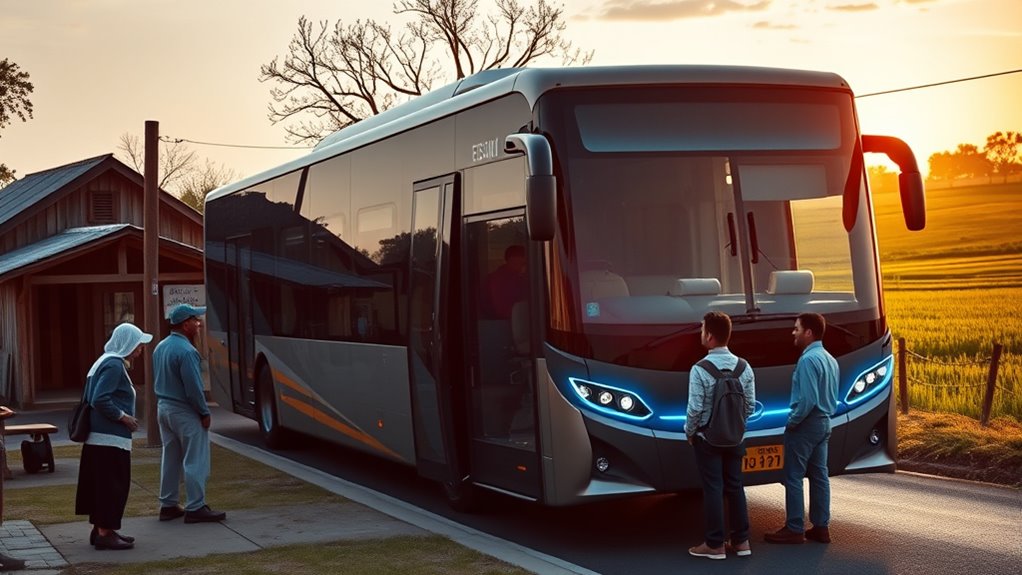Building trust in electric buses in rural areas hinges on developing reliable charging infrastructure and actively engaging the community. When you involve residents, share success stories, and demonstrate how electric buses improve air quality and lower costs, acceptance grows. Familiarity through demonstrations and open communication helps dispel concerns. If you want to discover proven strategies for shifting local perceptions and ensuring a smooth progression, keep exploring how community participation and infrastructure matter most.
Key Takeaways
- Community engagement and transparent communication foster trust and dispel misconceptions about electric buses.
- Demonstrations and firsthand experiences increase familiarity and acceptance among residents.
- Developing accessible charging infrastructure reassures the community of reliable operation.
- Showcasing health, economic, and environmental benefits builds support and positive perception.
- Involving local organizations and schools during events boosts pride and ownership in electric transit projects.

Rural communities are increasingly exploring electric buses as a sustainable transportation option, but their acceptance depends on various factors. One of the most critical is the development of reliable charging infrastructure. Without accessible and efficient charging stations, residents and transportation providers may hesitate to embrace electric buses, fearing they’ll be stranded or face long downtimes. You need to see charging stations as a cornerstone of confidence in electric vehicle adoption. When charging infrastructure is well-planned and conveniently located, it reduces range anxiety and demonstrates a commitment to supporting electric transit. This reassurance encourages community members to view electric buses as a viable alternative to traditional diesel options.
Reliable, accessible charging stations build trust and confidence in rural electric bus adoption.
Community engagement plays a essential role in shaping perceptions around electric buses. It’s not enough to simply install charging stations; you must actively involve local residents, leaders, and stakeholders in the transition process. When you engage the community through informational sessions, demonstrations, and open forums, you foster transparency and trust. People are more likely to accept electric buses when they understand their benefits—such as lower emissions, quieter operation, and potential cost savings—and when they feel their concerns are heard. Addressing questions about safety, maintenance, and costs directly helps dispel misconceptions and builds a sense of ownership and pride in the project.
Furthermore, community engagement isn’t a one-time effort; it’s an ongoing process. Regular communication about the progress of infrastructure development and the positive impacts of electric buses keeps the community invested. You should also highlight success stories from similar rural areas, showcasing how electric buses have improved air quality and reduced operational costs. This kind of storytelling resonates deeply because it connects the technology to tangible benefits for residents’ health and local economy. Additionally, understanding key factors like technology adoption can help communities better facilitate acceptance and integration of electric buses into daily life.
In addition, involving local organizations and schools can strengthen support. When community members see electric buses in action—perhaps during school trips or community events—they develop firsthand familiarity and comfort with the technology. This familiarity often translates into acceptance and even enthusiasm. Ultimately, the acceptance of electric buses in rural areas hinges on building a thorough approach that emphasizes robust charging infrastructure and meaningful community engagement. When you prioritize these factors, you create an environment where electric transportation feels like a natural, beneficial evolution for your community, rather than a distant or unfamiliar concept.
Frequently Asked Questions
How Do Electric Buses Perform in Extreme Weather Conditions?
Electric buses perform well in extreme weather conditions, thanks to improved battery durability and temperature resilience. You’ll find that their batteries are designed to withstand cold and heat, maintaining performance even in harsh climates. While cold weather can temporarily reduce range, modern thermal management systems help keep batteries operating efficiently. Overall, with proper maintenance, electric buses remain reliable and effective, even during extreme weather, ensuring consistent transportation service in rural communities.
What Are the Long-Term Cost Savings for Rural Transit Agencies?
Imagine your rural transit agency thriving with long-term savings. You’ll benefit from improved battery longevity, reducing replacement costs, and a reliable charging infrastructure that keeps buses running smoothly. Over time, these investments cut fuel expenses and maintenance, boosting your budget’s stability. You’ll see your fleet operate more efficiently, saving money month after month, and enabling better service for your community’s needs—making the switch to electric buses a smart, cost-effective decision.
How Do Rural Residents Perceive Electric Bus Safety?
You might worry about perceived safety concerns with electric buses, but many rural residents are starting to trust the technology. As transit agencies share safety information and demonstrate reliability, your confidence grows. You may still have questions about battery safety or emergency procedures, but ongoing education and transparent communication help build trust. Overall, with proper information, you’re more likely to see electric buses as safe and a positive change for your community.
What Maintenance Challenges Are Unique to Rural Electric Buses?
You face unique maintenance challenges with rural electric buses, like battery degradation from infrequent charging cycles. Imagine a farmer’s tractor sitting idle for months—similar issues occur with batteries without regular use. Limited charging infrastructure complicates routine upkeep, making repairs more difficult and costly. You need reliable access to charging stations and proactive monitoring to prevent battery issues, ensuring your buses stay safe and operational in remote areas.
How Can Community Engagement Improve Electric Bus Acceptance?
You can boost electric bus acceptance by actively promoting community involvement and launching targeted education campaigns. When you engage residents through town hall meetings, demonstrations, and local events, you build trust and address concerns firsthand. Clear, accessible information about the benefits and operational aspects of electric buses helps dispel misconceptions. Your efforts foster familiarity and confidence, making residents more receptive and supportive of adopting electric transportation in their rural communities.
Conclusion
As you embrace the changing tides of transportation, you’ll find that rural communities are awakening like a dawn breaking through the fog. Electric buses, once viewed with skepticism, now shimmer like promising stars on the horizon, guiding us toward a cleaner, sustainable future. Your openness to this shift acts as the compass steering us away from the storm of pollution, toward a horizon where innovation and tradition walk hand in hand, shaping a brighter tomorrow.









